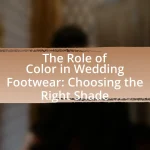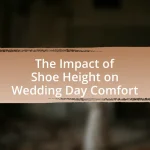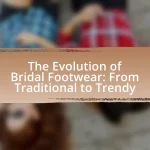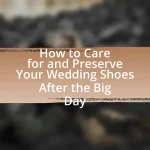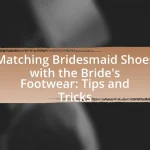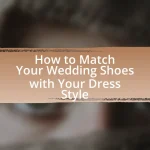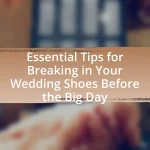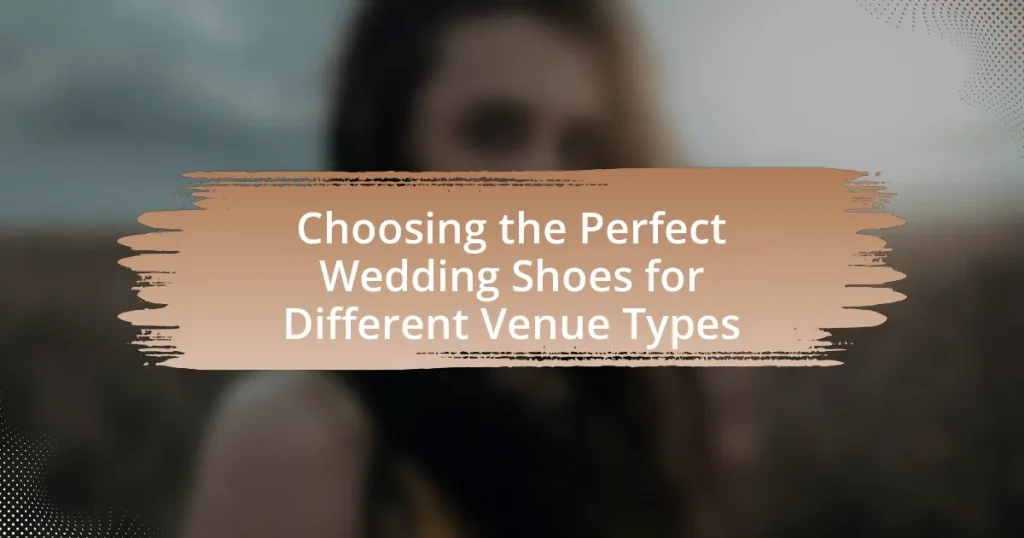Choosing the perfect wedding shoes for different venue types is essential for ensuring comfort and style on the big day. Key factors to consider include the venue type, terrain, and comfort level, as these elements dictate the appropriate shoe style and functionality. Outdoor venues require shoes with stability and grip, while formal indoor settings allow for more elegant options. Comfort features such as cushioning and proper fit are crucial for long hours of wear, as weddings often involve extensive standing and dancing. This article provides insights into suitable shoe styles for various venues, practical considerations for comfort, and tips for avoiding common mistakes in shoe selection.
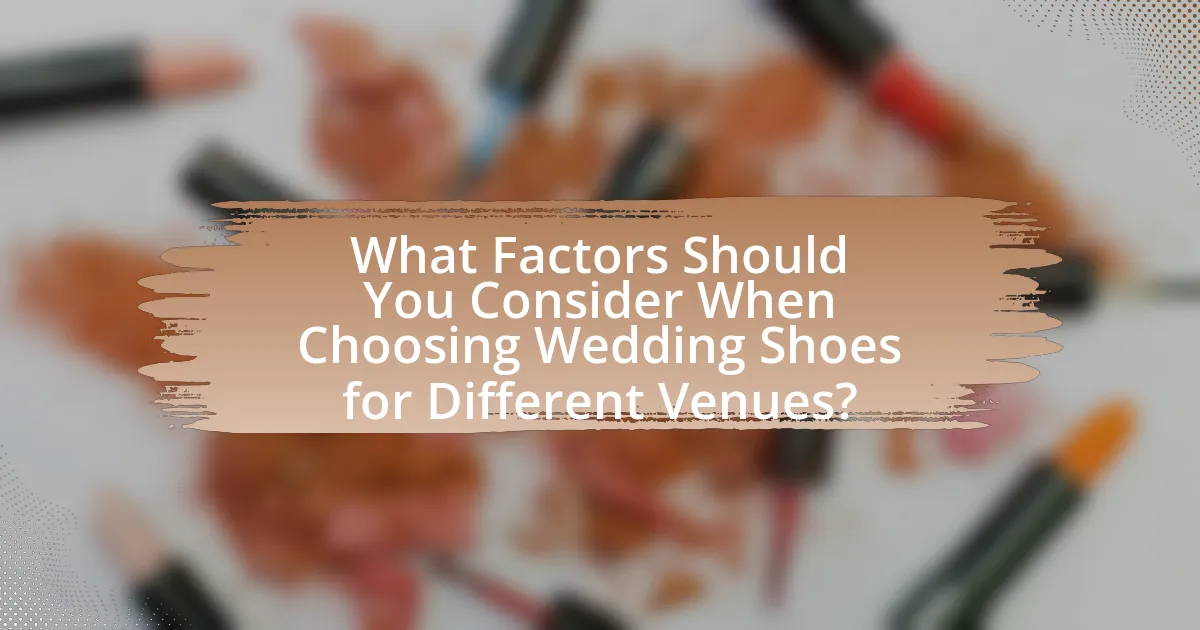
What Factors Should You Consider When Choosing Wedding Shoes for Different Venues?
When choosing wedding shoes for different venues, consider the venue type, terrain, and comfort level. The venue type dictates the style and formality of the shoes; for example, a beach wedding requires sandals or flats, while a formal indoor venue may call for heels. Terrain affects shoe stability; outdoor venues with grass or uneven surfaces necessitate shoes with better grip and support. Comfort is crucial, as weddings involve extended periods of standing and dancing; selecting shoes with cushioning and proper fit can prevent discomfort. These factors ensure that the chosen shoes are appropriate for the specific venue and enhance the overall wedding experience.
How do venue types influence your choice of wedding shoes?
Venue types significantly influence the choice of wedding shoes by dictating the style, comfort, and practicality required for the event. For instance, outdoor venues like gardens or beaches necessitate shoes that provide stability and grip, such as wedges or flats, to prevent sinking into soft ground or sand. In contrast, formal indoor venues, such as ballrooms, often allow for more elegant options like stilettos or dressy heels, which complement the sophisticated atmosphere. Additionally, the flooring type impacts shoe selection; hardwood or carpeted surfaces may accommodate different heel heights compared to uneven or grassy terrains. Therefore, understanding the venue type is crucial for selecting appropriate wedding shoes that balance aesthetics with functionality.
What are the characteristics of outdoor venues that affect shoe selection?
Outdoor venues typically feature characteristics such as terrain type, weather conditions, and surface stability, all of which significantly influence shoe selection. For instance, uneven or grassy terrains require shoes with better traction and support, such as wedges or block heels, to prevent slipping and provide stability. Additionally, wet or muddy conditions necessitate waterproof materials and non-slip soles to ensure safety and comfort. Furthermore, hard surfaces like concrete or stone may require cushioned soles to enhance comfort during prolonged standing or walking. These factors collectively guide individuals in choosing appropriate footwear that aligns with the specific demands of the outdoor venue.
How do indoor venues differ in shoe requirements?
Indoor venues differ in shoe requirements primarily based on the flooring type and the event’s formality. For example, venues with hardwood or polished floors often necessitate shoes with smooth soles to prevent scuffing, while carpeted venues may allow for more varied shoe types, including those with rubber soles for better grip. Additionally, formal indoor venues typically require dressier footwear, such as heels or polished shoes, whereas casual indoor settings may permit more relaxed styles like flats or loafers. This distinction is crucial for ensuring comfort and appropriateness during the event.
What styles of wedding shoes are suitable for various venues?
For outdoor venues, such as gardens or beaches, flat sandals or wedges are suitable due to their comfort and stability on uneven surfaces. In contrast, formal indoor venues like ballrooms typically call for elegant heels or dressy pumps, which enhance the overall sophistication of the attire. For rustic venues, such as barns, ankle boots or stylish flats can provide both style and practicality, accommodating the often uneven terrain. Additionally, for destination weddings in tropical locations, breathable materials and open-toed styles are ideal for comfort in warm climates. Each shoe style aligns with the venue’s characteristics, ensuring both aesthetic appeal and functionality.
What are the best shoe styles for beach weddings?
The best shoe styles for beach weddings are sandals, espadrilles, and flats. Sandals provide breathability and comfort, making them ideal for sandy environments. Espadrilles, often made with canvas or cotton fabric and a jute sole, offer a stylish yet casual option that complements beach attire. Flats, particularly those with a flexible sole, ensure ease of movement on uneven surfaces like sand. These styles are favored because they prevent sinking into the sand and allow for a relaxed, elegant look suitable for a beach setting.
Which shoes are ideal for formal indoor ceremonies?
Formal indoor ceremonies are best suited for dress shoes such as oxfords, loafers, or heels. These types of shoes are designed to complement formal attire, providing a polished and sophisticated appearance. Oxfords, for instance, are characterized by their closed lacing system and sleek design, making them a classic choice for men. Loafers offer a more relaxed yet elegant option, while heels can enhance the overall look for women, adding height and style. The appropriateness of these shoe types is supported by fashion guidelines that emphasize the importance of matching footwear with formal attire to maintain a cohesive and refined look.
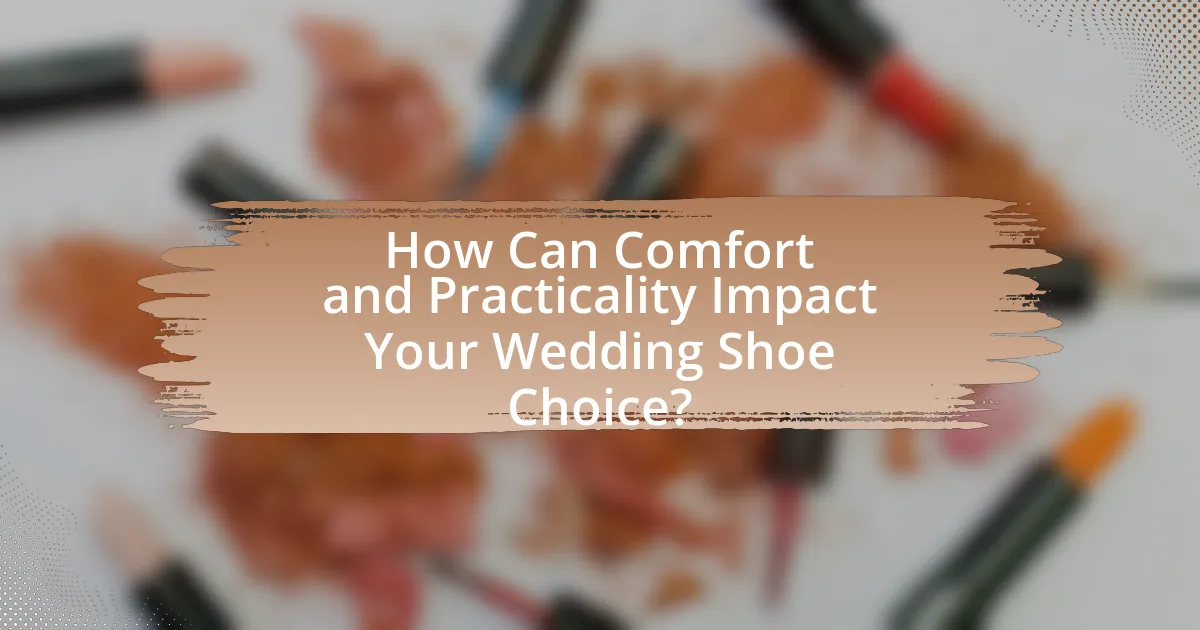
How Can Comfort and Practicality Impact Your Wedding Shoe Choice?
Comfort and practicality significantly influence wedding shoe choice by ensuring that the wearer can enjoy the event without discomfort or mobility issues. Comfortable shoes reduce the risk of blisters and fatigue, allowing the bride or groom to focus on the celebration rather than their feet. Practicality, such as the shoe’s ability to navigate various terrains—like grass, sand, or indoor flooring—ensures stability and safety throughout the day. For instance, a study by the American Podiatric Medical Association highlights that 72% of women experience foot pain from wearing inappropriate footwear, underscoring the importance of selecting shoes that balance style with comfort and functionality.
Why is comfort important when selecting wedding shoes?
Comfort is crucial when selecting wedding shoes because it directly impacts the wearer’s ability to enjoy the event without physical discomfort. Weddings often involve long hours of standing, walking, and dancing, which can lead to foot pain if the shoes are not comfortable. Studies indicate that discomfort can detract from the overall experience, making it essential to choose shoes that provide adequate support and cushioning. For instance, shoes with arch support and a cushioned insole can significantly reduce fatigue and discomfort during extended wear, allowing the wearer to focus on celebrating rather than managing pain.
How can you ensure your wedding shoes are comfortable for all-day wear?
To ensure your wedding shoes are comfortable for all-day wear, select shoes that provide adequate support and cushioning. Look for features such as arch support, padded insoles, and a comfortable heel height, ideally no more than two to three inches, as studies indicate that lower heels reduce strain on the feet and back. Additionally, consider breaking in the shoes before the wedding day to allow your feet to adjust, which can significantly enhance comfort during extended wear.
What features should you look for in comfortable wedding shoes?
Comfortable wedding shoes should have features such as cushioning, arch support, a secure fit, and a non-slip sole. Cushioning helps absorb impact, reducing fatigue during long hours of wear. Arch support is essential for maintaining foot health and comfort, especially if standing or dancing for extended periods. A secure fit, often achieved through adjustable straps or laces, prevents slipping and blisters. Lastly, a non-slip sole enhances stability on various surfaces, ensuring safety throughout the event. These features collectively contribute to a comfortable experience, making them crucial for wedding footwear.
What practical considerations should you keep in mind for different venues?
When choosing wedding shoes for different venues, consider the terrain and flooring type, as these factors significantly impact comfort and stability. For outdoor venues, such as gardens or beaches, opt for shoes with a wider base or flat soles to prevent sinking into soft ground. In contrast, indoor venues with hardwood or tile floors may allow for heels, but ensure they are not too high to avoid discomfort during extended wear. Additionally, consider the weather conditions; for example, waterproof materials are essential for rainy outdoor settings. Lastly, the overall theme and formality of the venue should align with the shoe style, ensuring a cohesive look.
How do weather conditions affect shoe choice for outdoor weddings?
Weather conditions significantly influence shoe choice for outdoor weddings. For instance, in wet or muddy conditions, waterproof shoes or those with a sturdy grip are essential to prevent slipping and discomfort. Conversely, in hot weather, breathable materials and open-toed designs are preferable to ensure comfort. Additionally, during windy conditions, shoes with secure straps can help maintain stability. These considerations are crucial as they directly impact the wearer’s comfort and safety throughout the event.
What should you consider about flooring types in indoor venues?
When considering flooring types in indoor venues, it is essential to evaluate the material’s texture, stability, and comfort level. Different flooring materials, such as hardwood, tile, carpet, or laminate, can significantly impact the choice of wedding shoes. For instance, hardwood floors provide a stable surface that is suitable for heels, while carpet may require shoes with a broader base for better balance. Additionally, the flooring’s slip resistance is crucial for safety, especially in venues where guests will be dancing. Research indicates that approximately 30% of falls in indoor settings are related to slippery surfaces, highlighting the importance of selecting appropriate footwear based on the flooring type.
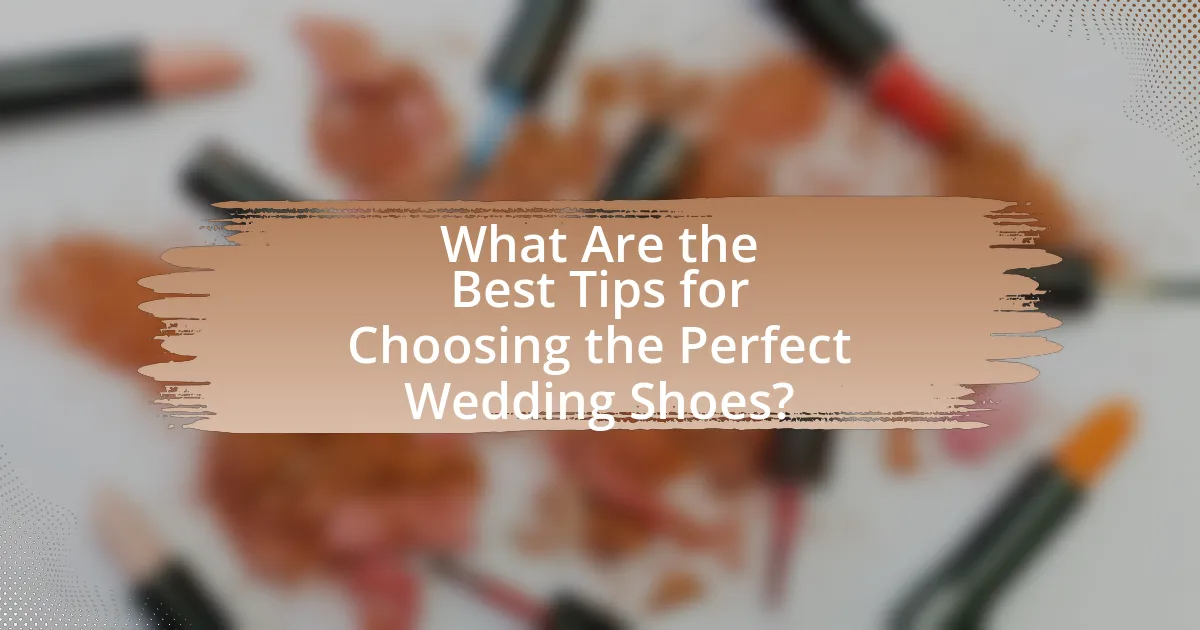
What Are the Best Tips for Choosing the Perfect Wedding Shoes?
The best tips for choosing the perfect wedding shoes include selecting a style that complements the wedding dress, ensuring comfort for long wear, and considering the venue type. A complementary style enhances the overall look, while comfort is crucial since weddings often involve extended periods of standing and dancing. For example, if the wedding is outdoors on grass, opt for shoes with a wider heel to prevent sinking. Additionally, materials should be chosen based on the season; breathable fabrics are ideal for summer, while closed-toe options work well in cooler months. These considerations ensure that the shoes not only look good but also provide the necessary support and functionality for the event.
How can you effectively match your wedding shoes to your dress and venue?
To effectively match your wedding shoes to your dress and venue, consider the style, color, and material of both the shoes and the dress, as well as the venue’s ambiance. For instance, if your dress is formal and the venue is a grand ballroom, opt for elegant heels that complement the dress’s fabric and embellishments. Conversely, for a beach wedding, choose stylish flats or wedges that align with the casual setting and allow for comfort on sand. Additionally, ensure the color of the shoes either matches or harmonizes with the dress; neutral tones often work well for versatility, while bold colors can make a statement. This approach ensures a cohesive look that enhances both the dress and the overall wedding theme.
What color and material options work best for different venue types?
For outdoor venues, earthy tones like beige or soft pastels in materials such as canvas or suede work best, as they complement natural surroundings and provide comfort on uneven terrain. Indoor venues, particularly elegant settings like ballrooms, benefit from classic colors such as white, silver, or gold in luxurious materials like satin or leather, which enhance the formal atmosphere. Beach venues call for vibrant colors like coral or turquoise in water-resistant materials such as rubber or synthetic fabrics, ensuring durability against sand and moisture. Each color and material choice aligns with the venue’s characteristics, enhancing both aesthetics and functionality.
How can you coordinate shoe styles with your wedding theme?
To coordinate shoe styles with your wedding theme, select footwear that complements the overall aesthetic and color palette of your wedding. For instance, if your wedding theme is rustic, opt for shoes made of natural materials like leather or suede in earthy tones. Conversely, for a formal theme, choose elegant heels or dress shoes that match the color of your bridal party attire. Research indicates that aligning shoe styles with the wedding theme enhances the visual coherence of the event, making it more memorable for guests.
What are some common mistakes to avoid when selecting wedding shoes?
Common mistakes to avoid when selecting wedding shoes include prioritizing style over comfort, failing to consider the venue, and neglecting to break in the shoes beforehand. Prioritizing style can lead to discomfort during the event, as many fashionable shoes may not provide adequate support for long hours of wear. Additionally, not considering the venue can result in inappropriate footwear; for example, heels may be unsuitable for a beach wedding. Finally, neglecting to break in new shoes can cause blisters and pain on the wedding day, making it essential to wear them prior to the event to ensure a comfortable fit.
How can you prevent last-minute shoe-related issues on your wedding day?
To prevent last-minute shoe-related issues on your wedding day, ensure you break in your shoes well in advance. Breaking in shoes allows them to conform to your feet, reducing the risk of blisters and discomfort. According to a study published in the Journal of Foot and Ankle Research, wearing new shoes for extended periods without prior use can lead to foot pain and injuries. Additionally, consider having a backup pair of shoes that are comfortable and suitable for your venue type, as this provides an immediate solution if your primary shoes become problematic.
What are the best practices for breaking in wedding shoes before the big day?
To break in wedding shoes effectively before the big day, wear them around the house for short periods, gradually increasing the duration to allow your feet to adjust. This practice helps to soften the materials and mold the shoes to the shape of your feet. Additionally, consider using thick socks while wearing the shoes to stretch them slightly, and walk on different surfaces to simulate the wedding day environment. According to a study published in the Journal of Foot and Ankle Research, wearing new shoes for at least 2-3 hours a day in the weeks leading up to an event can significantly reduce discomfort and blisters.

